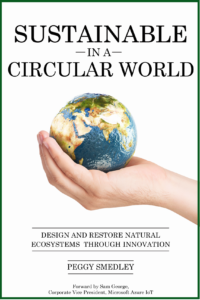I always say we must look back to see where we have been if we want to look forward to knowing where we are going. This method is myriad. We must look to the technology of our forefathers, and we must also look at our own successes and our own failure to know what went well and what didn’t. This will help inform us where we should head next.
Recently, on the 850th episode of The Peggy Smedley Show, I took a cue from Charles Dickens’ A Christmas Carol and I enjoyed journeying through different eras on each of the three segments of the show. We headed way back to the year 1973 to kick off the podcast and worked through the eras to ultimately reach present day and even future predictions for what comes next.
But for today’s blog I want to look back again. I want to recap the invention that continues to change all of our lives in ways we never could have imagined. This one special invention that was unveiled more than 50 years ago has paved the way for the Internet of Things and digital transformation as we know it today. It all began with Martin Cooper. Marty was a true pioneer in the wireless communications industry. After inventing the first portable cellular phone in 1973, he continued to contribute to the wireless industry for more than five decades. It was his vision for something different that helped shape the course of communications technology in the decades ahead.
In this past year, perhaps this goes without saying, but gen AI (artificial intelligence) has been one of the most talked about technologies. Gartner polled more than 1,400 executive leaders and found 45% reported they are in piloting mode with generative AI, and another 10% have put generative AI solutions into production.
As we look back, we know gen AI brings with it a set of challenges and opportunities. An MIT study suggests gen AI can improve a worker’s performance by as much as 40% compared with workers who don’t use it. Another AI Adoption in Software report shows teams who adopt AI can go 3.5 times faster.
But challenges persist. In July, Joshua Peschel, assistant professor and Black & Veach Faculty Fellow, Iowa State University, and I had a very candid conversation about gen AI on The Peggy Smedley Show. Perhaps one of the biggest takeaways was that if ChatGPT becomes a gatekeeper, how do we then develop the next generation of workers? Meaning, if gen AI is doing our entry level jobs for us, how do those new, young workers gain the experience to be able to do the higher manager and executive positions if gen AI is doing the boots-on-the-ground work for them?
Of course, gen AI is only one technology to consider. We also need to look at digital twin, Industry 4.0, quantum, machine learning, metaverse, AR (augmented reality), VR (virtual reality), and so much more.
With all this innovation at our fingertips, we have an opportunity to solve today’s challenges like labor, cybersecurity, and sustainability—and it all starts by looking back to look forward. I would like to challenge you to think about the last 12 months. What went well? What didn’t go well? Who led the technology charge? What new ideas do your employees have? How does it all fit in with what you are already doing?
Maybe you can try this exercise this week, as we ramp up for 2024. What went well in the last year—and what was a complete flop? Join me next week, as we look to the future. It’s time to take our knowledge from the past and apply it to what comes next. It’s time to create that playbook of the future and build on the lessons learned. We must look back to move forward with even greater success. We can do better, and we will, if we learn from our mistakes and work on growing the opportunities of the future. Stay tuned.
Want to tweet about this article? Use hashtags #IoT #sustainability #AI #5G #cloud #edge #futureofwork #digitaltransformation #green #ecosystem #environmental #circularworld


